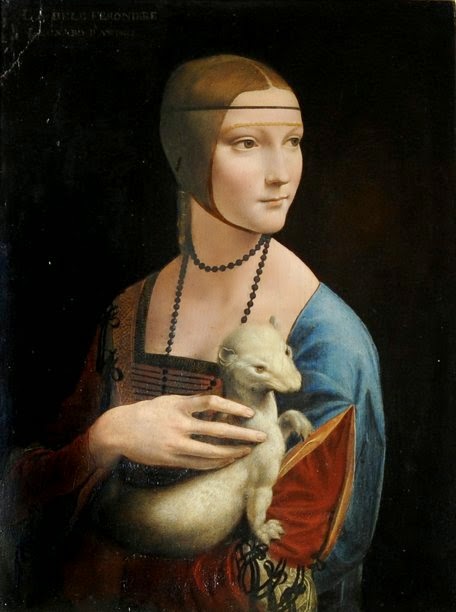The Lady with an Ermine is a remarkable early life
portrait by Leonardo da Vinci. The subject is a teen mistress of the Duke of
Milan known as Cecilia Gallerani (1473-1536) (1).
She was considered extremely beautiful and was considered a poet, scholar, and
lover of music. Most people found her to be funny and bubbly in personality
bringing freshness of spirit to her lover. Her upbeat personality immortalized
into a painting over 500 years ago.
At present the painting is hosted at the Wawel Castle in Krakow, Poland (2). It is 40.3 cm wide and 54.8 tall by dimension (3). The Lady with an Ermine is an oil painting on walnut board. It is a representation of craftsmanship that few artists experience in terms of quality, depth, simplicity and design. You can see an example in the lines that run from her arm and down the back of the animal. Leonardo was great at creating representations and symbols within his work which added to his legend.
Cecilia Gallerani is depicted looking away from the audience with indifference and holding a pet ermine in an alert state. The ermine is watching something and she is lightly controlling its neck with her enlarged hands. Her tunic is simple but is depicted as wearing expensive pearls. The picture appears to be a representation of the simple beauty of innocence matched with the expensive power of her lover.
At present the painting is hosted at the Wawel Castle in Krakow, Poland (2). It is 40.3 cm wide and 54.8 tall by dimension (3). The Lady with an Ermine is an oil painting on walnut board. It is a representation of craftsmanship that few artists experience in terms of quality, depth, simplicity and design. You can see an example in the lines that run from her arm and down the back of the animal. Leonardo was great at creating representations and symbols within his work which added to his legend.
Cecilia Gallerani is depicted looking away from the audience with indifference and holding a pet ermine in an alert state. The ermine is watching something and she is lightly controlling its neck with her enlarged hands. Her tunic is simple but is depicted as wearing expensive pearls. The picture appears to be a representation of the simple beauty of innocence matched with the expensive power of her lover.
The ermine in her hands as been known in the old world as a protector of the pregnant highlighting that she may have been pregnant at the time of the painting (4). Ermines were also an object for the powerful that made their way into clothing and royal emblems (5). To some this an indication that she was a powerful participant in a leading family without a blood relationship.
X-ray analysis of the picture reveals that a door has been removed from the background and what looks like hair originally was a covering veil (6). If this is true then the veil becomes known as a symbol of beauty and protection (7). It could mean that her purity is owned and protected by the Duke of Milan in a pseudo marriage relationship. In essence, he loved and protected her.
Either way the painting is an astounding representation of the life of a young lady in the Court of Milan. She stayed in the castle after the Duke Lodovico Sforza married Beatrice d'Este (8) and bore a son. When Beatrice found out about the relationship, Cecilia was forced out of the castle and married to the lower Count Ludovico Carminati de' Brambilla. She had more children before passing away.
